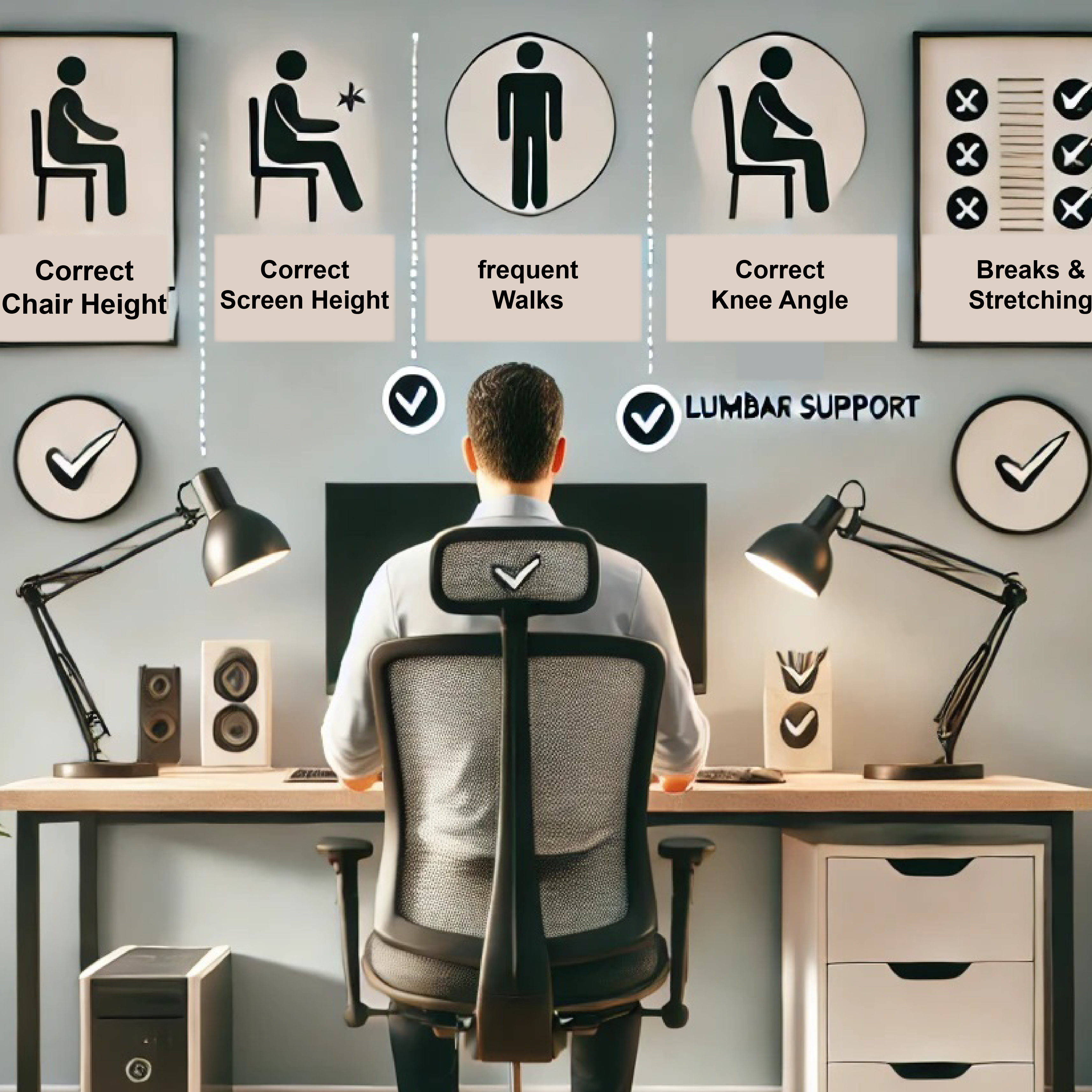
Ergonomic Tips for Remote Workers in 2025
Introduction
Homeworking practice has transitioned from the pandemic being a temporary phenomenon to a permanent readiness for teams with several benefits and drawbacks as to the employees’ health. Most teleworkers lack the ergonomic offices that provide proper ergonomics to support spine and muscular systems hence off-track posture, wrong furniture, and increased time spent in front of screens causing musculoskeletal disorders. Here, we present some recommended guidelines to ensure that one’s home office is safe and ergonomic for the muscles and skeleton in order to increase the efficiency of work.
Why Ergonomics Are Important to Remote Employees
Ergonomics primarily dealing with the work environment that accommodates its natural postures and movements avoiding stress on muscles and skeletal system. Inadequate ergonomics will cause a variety of neuromusculoskeletal disorders such as lower back pain, neck stiffness, and carpal tunnel disorders. Musculoskeletal disorders are responsible for absence from work as pointed out by the American Academy of Family Physician where it was estimated that American businesses lose billions of dollars annually. Some changes can be easily performed in order to provide comfort and productivity for the long term use of the home office.
Ergonomics Insights for Working from Home
1. Invest in an Ergonomic Chair
The chair you use is very important in determining your posture and the general amount of comfort that you experience when in that particular chair. There are few characteristics that you can look for – it should be an ergonomic chair that offers the lumbar spine support, which should be adjustable to your seat and table height and, at the same time the feet should touch the floor comfortably. An ideal ergonomic chair should ensure that your lower back region fits the natural contours of the curve in your spine so as not to add extra pressure to your spine.
Tip: If you can’t have an ergonomic chair, try using a rolled towel or cushion between your lower back and the chair.
2. Learn How to Position Your Monitor
Having the right placement of monitors curtails neck and eye strain. Research suggests that maintaining the monitor at a comfortable viewing distance, with the top of the screen at or slightly below eye level, can help minimize these issues. Ideally, the top edge of your monitor should be at or slightly below eye level and should be placed at an arm’s length from you. Do not work at a downward position; this angle puts a lot of stress on the neck area.
Tip: Set a laptop on a stand so that you can raise the screen to the eye level. If you don’t have a planned budget for the monitor riser you can stack books or use a large box for the same.
3. Adjust Your Desk Setup
Proper positioning of your computer monitor is essential for maintaining good posture and reducing strain on your eyes, neck, and back. An ergonomic workplace design means that your elbows fall at 90 degrees to the surface of the desk while you type. According to the academic literature on ergonomics, the ideal desk setup involves positioning the screen so that the top third aligns with the user’s eye level, while also placing the screen approximately an arm’s length away. Select a desk which will allow you to place the keyboard and the mouse conveniently so that there is enough space for the arms to be placed.
Tip: Should your desk be the wrong height, make sure you adjust the chair height so your feet rest flat on the floor with a footrest. :If your desk is too low then simply put it on sturdy risers if possible.
4. Ergonomic Keyboard and mouse
There is also the problem of a wrong and often uncomfortable positioning when typing and mousing; get an external keyboard/mouse. It also lets you have a more natural looking arm position and to put your screen at a better height. An ergonomic keyboard and mouse will benefit in improved posture, reduced fatigue, increased comfort, higher work productivity, better typing, and reduced risk of injury.
Tip: When looking for keyboards and mice try to get those that are labeled ergonomic since they are designed to prevent problems with the wrist and the hand. Additional split keyboards and vertical mice can help to increase comfort and if you work at a computer all day, it will benefit you.
5. Practice the 20-20-20 Rule
In an era where countless individuals find themselves tethered to desks and screens for prolonged periods, the 20-20-20 rule has emerged as a simple yet highly effective strategy to mitigate the detrimental effects of this. Readers of eBooks risk experiencing eye strain because they take their time reading by staring at screens. The premise of the 20-20-20 rule is straightforward – it recommends that every 20 minutes, individuals should shift their gaze away from the screen and focus on an object at least 20 feet.
Tip: Then put on an application like Eye Care 20 20 20 or use the alarm on your smartphone to remind you to avoid the monitor every now and then.
6. Maintain Proper Posture
The main factor that plays to avert strain on the body is good posture. When sitting, stand upright, shoulders should be down and head up and avoid crossing legs. The arch of your knees should form right angles with the thighs parallel to the floor.
- Sit up straight with your back straight.
- Keep your feet on the floor to balance your pelvis.
- Position your elbows by your sides so your arms form an L-shape.
- Sit with your hips far back in your chair.
- Keep your knees in line with your hips.
- Avoid clenching muscles or adopting an unnatural, stiff posture.
- Take breaks to get up and move around.
Tip: A posture-correcting cushion or lumbar support pillow might help if you have a Slouching problem. Moreover, there are applications, such as Upright or Posture Reminder, which are used to control and maintain proper sitting postures over the day.
7. Incorporate Movement Breaks
The main problem of Prolonged sitting is that people get sore and stiff. Use short walking or standing breaks every sixty minutes at least to extend and change positions. Special stretching of the neck, shoulders and back muscles has a beneficial effect on tension in muscles and increases the blood circulation.
Tip: Put alarms on your phone in intervals of roughly 45 minutes to 1 hour to guarantee that you stand up and have a break from typing or sitting for long hours. Other apps may help, such as Stretchly or Time Out.

Other factors to reduce risk of ergonomic injury
Ideally, a remote workspace must be as efficient and comfortable as it can be imagined. Here are some quick adjustments for optimal home office safety:
- Lighting: Ensure that where you work has enough light to help you avoid eye strain. Note that it is best to position your screen in a way antithetical to windows or light of computer monitor.
- Temperature Control: Make sure that your environment is clean and ergonomic, the air is fresh. Excessive heat or cold, producing heat stress through impaired air quality reduces tiredness and discomfort.
- Footrest: If your feet do not touch the floor while sitting, you may use the footstool or a small chair to hold your feet in a horizontal plane.
- Advantages of Effective Remote Environment
- Investing time in an ergonomic setup provides numerous benefits, including:
- Reduced Risk of Injury: The changes in the production workplace reduce work related repetitive strain injuries and musculoskeletal disorders.
- Increased Comfort: Proper organization of the workspace minimizes pain and lets your concentration maintain a high level of productivity.
- Improved Productivity: Wanting to avoid spending time fiddling with uncomfortable accessories, the body has the attention to focus on a task instead.
- Enhanced Mental Wellness: It must also noted that any form of physical discomfort can lead to stress. This means that one can create better working environment for physical and mental health contributing to.
Conclusion
Here, we listed the tips to make an ergonomic remote workspace is that people do not need to spend so much money or dedicate too much time to it. With these simple changes you will get more comfortable, decrease the risks to your health, as well as increase productivity. From getting a good chair to adjusting your computer screen or the 20/20/20 rule, there are substantial changes you could make to make a change to your day. Bear in mind that the long-term objective is to build a proper environment that would help your body work while you attend to your remote work.
Suggested Resources
- Home Office Ergonomics 2020 https://www.canada.ca/content/dam/eccc/documents/pdf/corporate-info/covid-19/2020-04-08_Ergo_TeleworkTips_E.pdf
- Ergonomics and human factors at work 2013 https://www.hse.gov.uk/pubns/indg90.pdf
- REMOTE WORK ERGONOMICS 2021 https://www.ehs.harvard.edu/sites/default/files/remote_work_ergonomics_fact_sheet.pdf
- ILO’s Ergonomic tips when teleworking 2020 https://www.ilo.org/resource/ergonomic-tips-when-teleworking
